
Dr. Paul j. Sullivan :
We live in exciting and challenging times, and these times are going to get even more exciting, challenging, and amazing as energy transitions develop.
The next few decades could see astonishing invention, investment, and change. The opportunities will be vast. My recommendation for younger people, if they have an interest in energy and related businesses and studies, is to focus on what the future may bring.
The world is looking to turn around two hundred years of energy transitions towards fossil fuels, which have already helped with increased wealth, fantastic inventions, vastly improved health, and so much more for many.
People in the Gulf Cooperation Council area have seen massive changes in their lives since the discovery and exploitation of oil and gas. Those who lived in the early 19th century anywhere in the world would never have guessed all the changes that have happened in the world of energy and in the energy of the world.
One does not need to go back very far in history to when there was no electricity and lighting except from whales, wood and agricultural residue; no transport other than camels, oxen, horses, or by foot, and no heating or cooling other than fireplaces or the ocean, mountains, or desert breezes. Our ancestors were a lot poorer energetically and economically.
However, it has become clear that this drive towards development and growth based on fossil fuels brought many challenges to our environment, which will get much worse if we do not change the way we do things.
The future of energy transition is towards electric transport, hydrogen, ammonia, wind, solar, tidal power, nuclear power, geothermal, energy storage, carbon capture sequestration and use, circular economies, as well as many technologies and methods we do not know about yet.
The exciting part of the coming decades is what we do not know, and what we cannot even guess might happen.
Fossil fuels will still be needed. They are used in many processes and products that we use every day, such as clothing, medicines, lubricants, petrochemicals, and thousands of others. But their demand for transportation and electricity production will decline as they are replaced by renewables, nuclear, increased energy efficiency, cogeneration, and so many new things and processes that baffle the mind.
Yes, we can all read about what many of top universities, think tanks, and international organizations are saying could happen over the next decades, but nobody knows for certain. A lot of the success of future energy transitions will be determined by the inventions and creativity that has not happened yet. And these surprises in inventions and investments could bring jobs, hope, and opportunities to many.
For GCC countries some of the biggest changes could happen as they shift the use of their gigantic oil and gas reserves to create hydrogen, ammonia, and other cleaner fuels. They are indeed putting huge investments into developing more solar and wind power. More efforts though, into the development of geothermal heat pumps and geothermal electricity, will be required from them.
Saudi Arabia, for example, has significant potential in geothermal for electricity production in its west, particularly near Makkah and Madinah.
Aramco and KAPSARC are taking the lead on a particularly important set of ideas for a better future to the region and the world: Circular carbon economies. One can apply the ideas of circular carbon economies to turn around the carbon problem into a carbon solution.
A circular economy turns what one would previously consider waste into something useful. It can also make producing oil, gas, and their refined products a lot cleaner. Carbon is not the enemy. Not using it correctly, or wasting it, is the enemy. Carbon dioxide can be sequestered underground or, even better, used to create other fuels, building materials, or as effective cleaning agents.The most important driving force behind the energy transitions of the future will be environmental and climate ones.
GCC leaders and government officials know this. They also know that many things must change. The Saudi Green Initiative and the Middle East Green Initiatives are solid examples of Saudi leadership showing that they understand.
The development of NEOM, which is to be solely run by renewable energy systems – even to desalinate water – is a solid example of creative thinking for a better future. NEOM is an idea whose time has come. Saudi Arabia could be a leader in the development of new types of cities if done right.
What many hope, including me, is that over the coming decades countries and their peoples will become more mature and rational with their production and use of energy and all the things connected with it.
We had enough time for our youthful urges for wealth and development, but often without tempering the maturity of thought towards our environment and climate.
We now have a chance to improve both. A better environment and climate are not mutually exclusive to better economies. They can feed off and improve each other.
It is time to grow up to a better future. Many of the leaders in the GCC region understood this; they can see many of the exceptionally good things this could bring.
(Dr. Paul Sullivan is a senior research associate at KFCRIS and non-resident fellow, Global Energy Center, Atlantic Council. Courtesy: Arab News).

